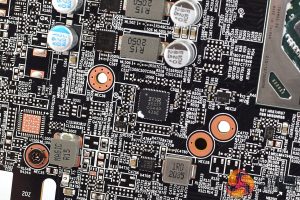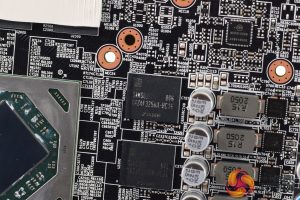The Gigabyte RX 6700 XT Gaming OC arrives in a black box, adorned with Gigabyte's robotic eye logo on the front. On the back, various key features of the graphics card are highlighted, including the triple fan setup and direct touch heatpipes.
Inside, the only accessory is this quick start guide.
As for the graphics card itself, as we alluded to on the previous page, it is a design we are now very familiar with. The Gaming OC uses a plastic shroud that’s mostly black but has some grey sections so it isn’t completely monotone. It’s very stealthy all-round with no colour on the card at all.
In terms of the fans, Gigabyte uses three 80mm fans, and as with all of its graphics card designs from the last couple of years, the central fan spins in reverse relative to the outer two, which Gigabyte claims helps to reduce airflow turbulence from the fans.
Dimensions are listed at 281 x 115 x 49mm, so it's not a massive card but modern standards, but it's hardly mini ITX-friendly.
The backplate is a full-length metal design, with the Gigabyte logo printed in white. There is a tiny cut-out in the metal towards the end of the card, which Gigabyte calls ‘screen cooling', and it's designed to allow air to pass directly through the heatsink… but given how small the cut-out is, I'm not sure exactly how much it will accomplish!
Elsewhere, we can see power requirements are the same as reference, with 1x 8-pin and 1x 6-pin PCIe connectors. Display outputs consist of 2x HDMI 2.1 and 2x DisplayPort 1.4.
Upon disassembly of the card, we get a good look at the PCB. Gigabyte is using what appears to be a very similar design to the reference card, with an 11-phase power solution that's split with 9 phases for the GPU and 2 phases for the memory. The GPU VRM is controlled by International Rectifier’s IR35217, while the memory controller used is OnSemi’s NCP81022N. Vishay SIC653A and SIC649A MOSFETs are used throughout.
The heatsink is comprised of three fin stacks, connected by a total of 5x 6mm copper heatpipes. Unlike the RX 6900 XT Gaming OC, which uses a copper baseplate, here the heatpipes make direct contact with the GPU die. We can also see a variety of secondary plates used to contact the VRM and memory via thermal pads.
The metal backplate contacts with the PCB thanks to a single, but large, thermal pad right behind the GPU die.
 KitGuru KitGuru.net – Tech News | Hardware News | Hardware Reviews | IOS | Mobile | Gaming | Graphics Cards
KitGuru KitGuru.net – Tech News | Hardware News | Hardware Reviews | IOS | Mobile | Gaming | Graphics Cards






















